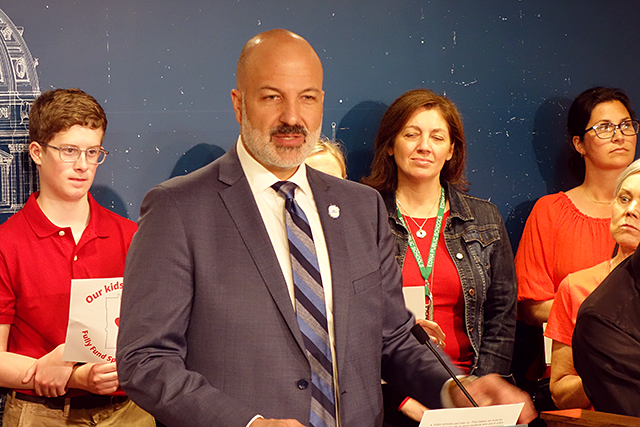If the Minnesota Legislature ever convenes in a special session, and if the fighting education committee chairs ever decide to agree on spending $1 billion from the surplus for schools, and if the other committee chairs reach agreement on their budget bills … it is likely that school districts across the state will get more money for special education.
But if the Legislature agrees to help resolve what is known as the special education “cross-subsidy,” it won’t increase funding for special education at all.
Confused? Welcome to the world of education finance in the United States and Minnesota.
Special education is a mandated service, and American public school districts are required to help students living with physical, mental and emotional disabilities. It isn’t just for students who enroll in public schools; it also must be provided for those at private schools, charter schools and home-schooled students.
But because it is mandated by the federal government — and because federal and state funding doesn’t actually cover the cost — districts move money from other budget areas to cover the costs. Thus, the cross-subsidy.
“Every single school district in Minnesota has a cross-subsidy — not enough money in the special education account to cover services,” said Rochester Public School Board Vice Chair Cathy Nathan.
And when there isn’t enough money specifically for special education, it is general education services that suffer. That, or districts ask local property taxpayers for levies to increase funding.
“Public schools are required by law to provide a free and appropriate education,” St. Paul School Superintendent Joe Gothard said earlier this month. “That means we can’t say no to any student who comes through our doors.”
When Congress imposed the mandate in the 1970s, there was a promise that federal money would cover 40 percent of the cost. But actual funding has never gotten close to that, falling now in the 10 to 14 percent range, Gothard said.
This year, a coalition of school districts and advocacy associations asked the Legislature to devote $822 million from Minnesota’s $9.25 billion surplus to fill that gap.

“Education organizations and advocates from across the state consistently rank cross-subsidy reduction as their number one issue,” Chamberlain wrote in a letter that accompanied one of his offers. “This is because special education costs can be unpredictable and difficult to budget for, and because reducing the cross-subsidy frees up local general fund dollars which schools can apply to their particular needs (i.e., early childhood, safe schools, student support personnel, etc.).”
The most recent House offer was for $195 million for the coming school year and $457 million for the two school years in the next budget period.
Nathan said the $19 million special education cross-subsidy in Rochester, “could instead be used to fuel the innovation we need to meet the ever more-complex social and emotional needs of our students.”
Yet sending state money to districts to reduce the impact of the cross-subsidy could also allow districts to reduce local property taxes. Mike Funk, the superintendent of the Albert Lea School District, said the cross-subsidy from his $53 million budget is $3.1 million, which is comparable to what local taxpayers approved in a levy of $3.9 million.
“Not all communities can afford this, and it creates an inequity for districts with higher special education costs and lower property values,” Funk said.

“What gets lost in this is it focuses on dollars and cents when it’s really about people,” Shaver said. “Students with disabilities are general education students first.”
That’s because most special education students only spend part of their day receiving those services and the rest in regular class settings.
Albert Lea’s Funk told of a student who was severely disabled and received a range of special help including for vision, deaf/hard of hearing, speech, language, physical therapy, occupational therapy, adaptive physical education, writing and social work. Yet that same student was separated from the general student population only 20 percent of the time.
“The consequences experienced because general education dollars are being shifted to pay for special education services that lead to increased class sizes, electives being cut, churn in the staff, hit students with disabilities because they’re general education students as well,” Shaver said.
“What could be provided with the general education dollars if you didn’t have to shift would benefit every child, including special education students,” he said. “They’re not missing out on special education services, they’re missing out on general education services.”
But if Senate GOP leader Jeremy Miller doesn’t agree with Gov. Tim Walz and House Speaker Melissa Hortman to keep working toward agreements and hold a special session later this spring to pass a series of budget and tax bills, it means “we have to deal with this for another year,” Shaver said.
Yet the cross-subsidy differences are only part of a broader disagreement between Chamberlain and Davnie, which involves the rest of the allotment for education and the philosophy about who to deliver it. Chamberlain has favored funding for literacy programs and opposes specific allocations that come with specific requirements. Davnie wants more money for student mental health programs and free lunch for all students regardless of income; he also wants to see increased funding for school support employees.
“The impact of the pandemic, the economic instability that too many families have faced these last few years, the effect of social media and other issues have stressed too many students and created a childhood unlike any childhood before,” said Davie, DFL-Minneapolis.
While the Senate’s version of an education budget bill has included some additional mental health counseling money in its offer, there remains a gap between the two sides.


0 Commentaires